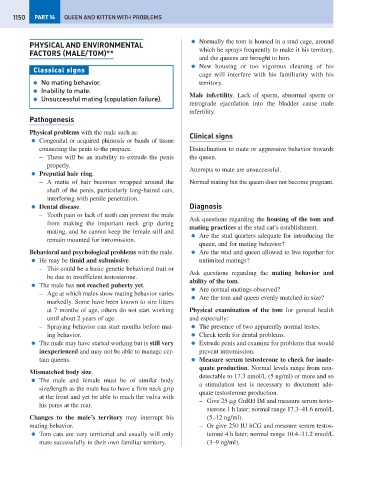Page 1158 - Problem-Based Feline Medicine
P. 1158
1150 PART 14 QUEEN AND KITTEN WITH PROBLEMS
● Normally the tom is housed in a stud cage, around
PHYSICAL AND ENVIRONMENTAL
FACTORS (MALE/TOM)** which he sprays frequently to make it his territory,
and the queens are brought to him.
● New housing or too vigorous cleaning of his
Classical signs
cage will interfere with his familiarity with his
● No mating behavior. territory.
● Inability to mate.
Male infertility. Lack of sperm, abnormal sperm or
● Unsuccessful mating (copulation failure).
retrograde ejaculation into the bladder cause male
infertility.
Pathogenesis
Physical problems with the male such as:
Clinical signs
● Congenital or acquired phimosis or bands of tissue
connecting the penis to the prepuce. Disinclination to mate or aggressive behavior towards
– There will be an inability to extrude the penis the queen.
properly.
Attempts to mate are unsuccessful.
● Preputial hair ring.
– A matte of hair becomes wrapped around the Normal mating but the queen does not become pregnant.
shaft of the penis, particularly long-haired cats,
interfering with penile penetration.
● Dental disease. Diagnosis
– Tooth pain or lack of teeth can prevent the male
Ask questions regarding the housing of the tom and
from making the important neck grip during
mating practices at the stud cat’s establishment.
mating, and he cannot keep the female still and
● Are the stud quarters adequate for introducing the
remain mounted for intromission.
queen, and for mating behavior?
Behavioral and psychological problems with the male. ● Are the stud and queen allowed to live together for
● He may be timid and submissive. unlimited matings?
– This could be a basic genetic behavioral trait or
Ask questions regarding the mating behavior and
be due to insufficient testosterone.
ability of the tom.
● The male has not reached puberty yet.
● Are normal matings observed?
– Age at which males show mating behavior varies
● Are the tom and queen evenly matched in size?
markedly. Some have been known to sire litters
at 7 months of age, others do not start working Physical examination of the tom for general health
until about 2 years of age. and especially:
– Spraying behavior can start months before mat- ● The presence of two apparently normal testes.
ing behavior. ● Check teeth for dental problems.
● The male may have started working but is still very ● Extrude penis and examine for problems that would
inexperienced and may not be able to manage cer- prevent intromission.
tain queens. ● Measure serum testosterone to check for inade-
quate production. Normal levels range from non-
Mismatched body size.
detectable to 17.3 nmol/L (5 ng/ml) or more and so
● The male and female must be of similar body
a stimulation test is necessary to document ade-
size/length as the male has to have a firm neck grip
quate testosterone production.
at the front and yet be able to reach the vulva with
– Give 25 μg GnRH IM and measure serum testo-
his penis at the rear.
sterone 1 h later; normal range 17.3–41.6 nmol/L
Changes to the male’s territory may interrupt his (5–12 ng/ml).
mating behavior. – Or give 250 IU hCG and measure serum testos-
● Tom cats are very territorial and usually will only terone 4 h later; normal range 10.4–31.2 nmol/L
mate successfully in their own familiar territory. (3–9 ng/ml).

